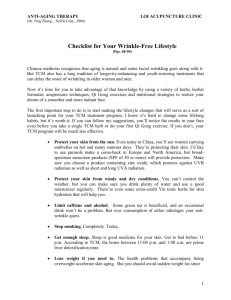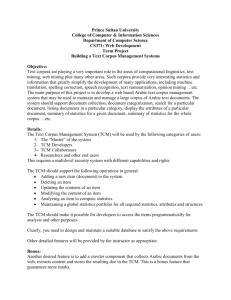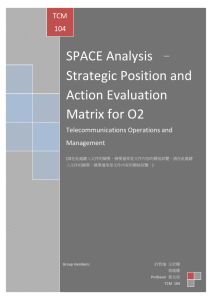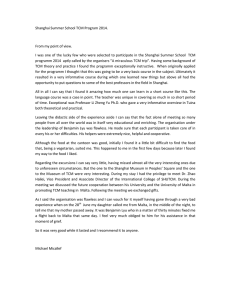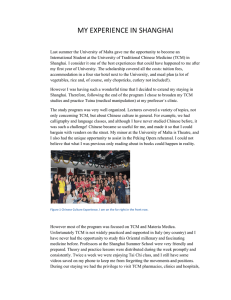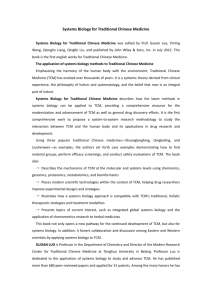Medicine in China 中国医疗体系 An Introduction Tom Xu
advertisement
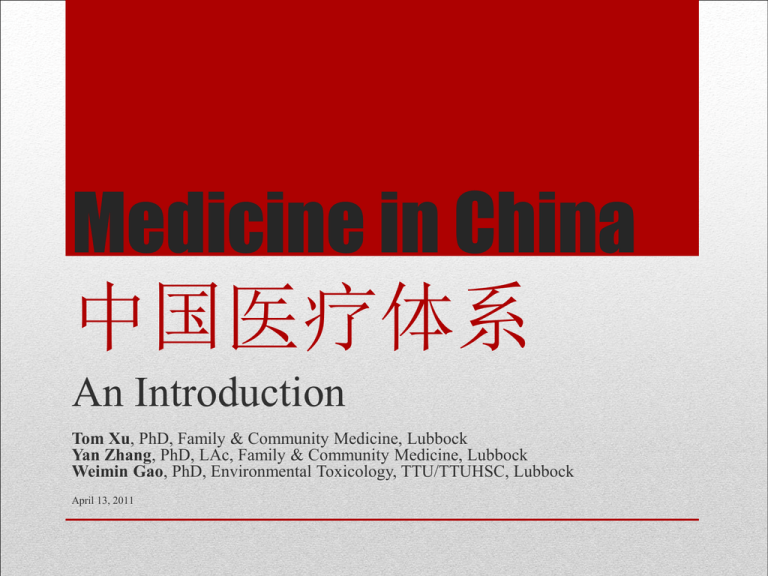
Medicine in China 中国医疗体系 An Introduction Tom Xu, PhD, Family & Community Medicine, Lubbock Yan Zhang, PhD, LAc, Family & Community Medicine, Lubbock Weimin Gao, PhD, Environmental Toxicology, TTU/TTUHSC, Lubbock April 13, 2011 • • • • • • The population The system A tour at an urban hospital in Southwest China Role of Traditional Chinese Medicine (TCM) Medical education and research Current and future collaborations Overview 2 China USA 1,341 million 0.6% 1.06 307 million 1% 0.97 0-15 years 16-59 years 60+ years Urban 21% 68% 11% 42% 21% 62% 17% 81% High School Graduates 15% 87% Total Population Population Growth Male:Female Population 3 China USA 15+ yo Mortality (/1,000) Infant Mortality (/1,000) Life Expectancy at Birth 116 109 20 7 73 78 72 – M 75 – M 75 – F 80 – F Leading Causes of Death Cancers Heart dz Stroke Cancers Respiratory dz Stroke Heart dz Respiratoary dz Health 4 < 5 yo Overweight < 5 yo Underweight Prevalence of Adult (15+) Tobacco Use Per Capita Adult Alcohol Consumption (in L, pure alcohol) China USA 9.2% 6.8% 7% 1.1% 31.8% 23.9% 5.2 8.6 Health 5 DTP for 1 yo HepB for 1 yo w/ Sustainable Drinking Water – Rural w/ Sustainable Drinking Water – Urban w/ Sustainable Sanitation – Rural w/ Sustainable Sanitation – Urban China USA 93% 91% 96% 92% 81% 94% 98% 100% 59% 99% 74% 100% Public Health 6 Hospital Beds (/10,000) Physicians (/10,000) Nurses and Midwives (/10,000) Ratio of Nurses and Midwives to Physicians Pharmaceutical Personnel (/10,000) China USA 22 14 32 26 10 94 0.7 3.7 3 9 Health Care Resources 7 GNP Per Capita (PPP int’l $) Population Living on <US$1/day % of Health Cost in GDP Per Capita Health Cost (PPP int’l $) Per Capita Health Cost at exchange rate (US$) China USA 7,740 44,260 9.9% – 4.7% 15.2% 315 6,350 81 6,350 Health Care Cost 8 % Paid for by Gov’nt % Gov’nt Spending in Health in All Gov’nt Spending Per Capita Gov’nt Spending in Health (PPP int’l $) % Paid for by Private % Out-of-Pocket in Private $ (co-pay) China USA 38.8% 45.1% 1% 21.8% 122 2,862 61.2% 54.9% 85.3% 23.9% Payers of Health Care 9 The Three-Tier System 10 • “Barefoot doctors” • Paramedical, some primary care and prevention • 2 doctors/1,000 population Village Medical Centers 11 • • • • • • Hospital-based 10-30 low acuity beds Primary role: outpatient clinic Population coverage: 10,000-30,000 Most qualified staff: assistant doctors Village + Town Medical Centers = Rural Collective Health System • Care for ~ 60% of the entire Chinese population Town Medical Centers 12 • 50-300 beds • Population coverage: 200,000-600,000 • Most qualified staff: senior doctors with a 5-year medical school degree • Major specialties • Imaging: XR, CT, MRI • Routine labs • Inpatient + outpatient The County Hospitals 13 • • • • • • • • • • 200-3,000 beds In all major cities All subspecialties All routine imaging, scopes, dialysis, some with cutting-edge varieties Specialty labs ICUs + designated ERs Inpatient + outpatient Most have branches throughout the city Affiliation with academics Only a few hospitals are privately owned Urban Hospitals 14 • All insurance plans have characteristics of managed care, such as choice limit and tiered copays. • Employees (and their family) of government, state-owned enterprises and universities: coverage with deductibles and copays • Urban employees of non-state-owned enterprises: uninsured, private insurance, or social welfare insurance if qualified • Urban unemployed: uninsured or social welfare insurance if qualified • Lack of credit system no money/insurance, no treatment, even in the ERs. Insurance In Urban China 15 • After the collapse of the old state-funded system in 1980s (including the barefoot doctor program), many struggle to pay medical bills or simply forego care. • 2005 New Rural Co-operative Medical Care System (NRCMCS) • Annual cost ¥50 (~$7): central government ¥20, provincial government ¥20, and participant ¥10. • >80% of rural population have signed up • Tiered copay: town hospitals (20-30%), county hospitals (40%), urban hospitals (70%) Insurance in Rural China 16 • Lack of general acceptance of primary care • No gatekeeping physicians. Similar to Fee-For-Service era in the US. No access barriers to specialists. • Prevalent self-referral • Rarely any discussion of medication compliance, prevention, and health behavior during a visit due to highly pressured workload (50 to 100+ patients per day) Primary Care 17 • “Reputable” pharmacies reside inside hospitals • More expensive but less likely to have expired drugs or simply packed flour powder • Some prescription medications are only available at hospitals • Street pharmacies are hit-or-miss • Can be a physician’s additional source of income • Commissioned by certain manufacturers • Bonus indirectly tied to pharmacy revenue: different departments in the same institution • Medical Reform Plan (2009-2011): promotes the separation of hospitals and pharmacies, and privatization of pharmaceutical products Pharmaceuticals 18 An Urban Hospital 19 • • • • • • • City Population: 11 million Provincial capital # of beds: 2,300 # of specialties and subspecialties: 72 # of outpatient + ER visits: 3 million # of hospital d/c: 68,000 # of operations: 54,000 An Urban Hospital 20 Registration/Appt. 21 To Clinics 22 Waiting Room 23 Ophthalmology Clinic 24 Price Check / Cashier 25 Labs 26 Pharmacy 27 Outpatient Prices 28 Inpatient Prices 29 Dialysis 30 Emergency Room 31 Emergency Room 32 Trauma Bay 33 “Cafeteria” 34 A County Hospital 35 A County Hospital TRADITIONAL CHINESE MEDICINE (TCM) 37 • Traditional Chinese Medicine (TCM) is a comprehensive system for the assessment and treatment of acute and chronic disorders, as well as preventative health care and maintenance. • • • • • Acupuncture and Moxibustion Herbal Medicine Tuina (Medical Massage) Qigong and Meditation Diet and Lifestyle What is TCM? 38 • TCM is under the administration of State Administration of TCM and Pharmacology. • TCM is now available to 75% of the areas in China. • In 2005, the output value of TCM amounted to RMB110.3 billion (about $13.8 billion), accounted for a quarter of the overall output value in China's medical industry. • The net yield and profits of TCM production is much higher than the average for the country's medical industry. • The total TCM market in China will rise to $23.5 billion in 2015. TCM Practice and Market 39 Integrative Medicine in China 40 • Combination of WM and TCM in diagnosis and treatment • applying disease identification in biomedicine and syndrome differentiation in TCM, and • applying treatment with biomedicine drugs and TCM herbal formula • Currently, across the nation: • 300 IM hospitals, • 30 IM departments in medical universities, • more than 100 IM-specific institutes. IM Clinical Practice Mode 41 • Clinical practice in TCM hospitals usually includes IM approaches. • Diagnosis: patients obtain both WM diagnosis and TCM syndrome differentiation. • Treatment: patients mainly obtain herbal medicine. However, they may also receive some WM treatment depending on their condition. IM in TCM Hospitals 42 • IM approaches are included in clinical practice in many WM hospitals. • Clinical practice in the WM hospital usually follows a biomedical model. • There is a department of TCM in most WM hospitals in China, • TCM doctors are asked to participate in the treatment for some patients (as requested by patients or by WM doctors). IM in WM Hospitals 43 Recognition of IM in China, 2004 100.00% 91.21% 93.52% 90.00% 80.00% 71.20% 70.00% 65.45% 60.00% 50.00% 40.00% 30.00% 20.00% 10.00% 0.00% MP consider IM as best dianogistic methods MP consider IM as best treatment methods Pt favored IM hospitals Pt favored IM therapies Recognition of IM 44 TCM and Health Investment 45 • • • • • Harmony between humanity and nature Harmony of physical and mental health Balance of Yin and Yang Prevention of disease Promotion of health and longevity Key Concepts 46 47 48 49 50 Challenges 51 MEDICAL EDUCATION 52 Workforce 53 Medical School Graduates 54 Admission & Enrollment 55 Gao T, et al. Medical education 1999; 33: 768-773 • High school graduates are admitted by the central education system based on their scores of the national entrance examination and ranking by students and schools. • About 550 secondary medical-pharmaceutical schools • Over 120 medical-pharmaceutical universities • About 30 colleges of traditional Chinese medicine Admission & Enrollment 56 • • • • Secondary (vocational) schools: 3 years Universities: 5 to 8 years No licensing examinations No centralized accreditation body for medical schools and universities. Licensing & Accreditation 57 Curriculum – 5 Years 58 Schearz MR, et al. Medical teacher 2004: 26(3):215-222 Curriculum – 7 Years 59 Schearz MR, et al. Medical teacher 2004: 26(3):215-222 • Year 1: general natural and social sciences: taught in the university (e.g. Peking University) • Years 2–3: medical sciences • Years 4–6: clinical rotations • Year 7: sub-internship in specialized fields • Dissertation is required for graduation Curriculum – 7 Years 60 5 vs. 7 Years 61 Schearz MR, et al. Medical teacher 2004: 26(3):215-222 • Leading to the degree of Doctor of Medicine (MD): medical scientists and educators • Been in Peking Union Medical College (PUMC) since 1917, founded by the Rockefeller Foundation. • 4 parts: • • • • Premed: 2.5 years Basic medical sciences: 1.5 years Clinical medicine and rotations: 3 1/3 years Research: 2/3 year Curriculum – 8 Years 62 RESEARCH COLLABORATIONS 63 Most Respected TCM and WM Research Institutes 64 • Collaboration with Chinese Academy of Medical Sciences & Peking Union Medical College • Characterization of Chinese Herbal Medicine in Treating Diabetic Patients (revision) • Use of Compound Chinese Medicine in the Treatment of Lung Cancer (Current Drug Discovery Technology, 2010, pp32-36) • Curcumin modulates eukaryotic initiation factors in human lung adenocarcinoma epithelial cells (Molecular Biology Reports, 2010, pp3105-3110) Research Collaborations 65 • Collaboration with Cancer Institute & Hospital / Chinese Academy of Medical Sciences • Cancer early detection and prognostic prediction using biomarkers Research Collaborations 66 • Collaboration with Nanjing Medical University, School of Public Health • Environmental and human health • Cancer molecular epidemiology • Collaboration with Jinling Hospital, Nanjing, Jiangsu Province • Detection of RASSF1A promoter hypermethylation in serum from gastric and colorectal adenocarcinoma patients Research Collaborations 67
